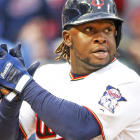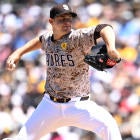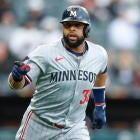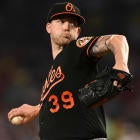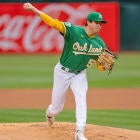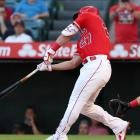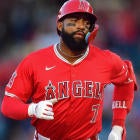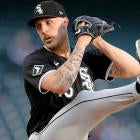It's time for Week 4 (April 24-30) of the Fantasy Baseball season. Unlike the Blue Jays, your season probably isn't over yet, so here's what you need to know.
No team has only five games
There is no obvious team to avoid this week, which is great news. Just play your best players.
6 games: ATL, BAL, BOS, CHC, CHW, CIN, CLE, DET, HOU, KC, MIA, MIL, MIN, NYM, NYY, OAK, PHI, PIT, SEA, STL, TB, TEX
7 games: ARI, COL, LAA, LAD, SD, SF, TOR, WAS
The two-start pitchers are very interesting
Scott will go over the whole list later, but here's an incomplete list of two-start options you might be able to go pick up for Week 4: Francisco Liriano (@LAA, vs. TB), Matt Shoemaker (vs. OAK, @TEX), Wei-Yin Chen (@PHI, vs. PIT), Hyun-Jin Ryu (@SF, vs. PHI), Jason Vargas (@CHW, vs. MIN).
Joe Ross, unfortunately, has to travel to Colorado, so it'll be tough to rely on him. That's just bad luck.
The Red Sox, Reds, Pirates and Astros (!!!) are never striking out
Pulling back to the team level, no team has been more strikeout averse than the Red Sox, who go down on strikeouts on just 16.3 percent of their collective plate appearances. Low-strikeout guys like Mookie Betts and Andrew Benintendi lead the way, but Hanley Ramirez has even been more contact-conscious in the early going. This has come at some cost, however, as the team sports the lowest Isolated slugging percentage in the league. They might miss David Ortiz, but this isn't a team you want to target for streaming.
The Astros, surprisingly, aren't either. They have been a favorite for strikeout hunters over the years, however the additions of Nori Aoki, Brian McCann and Josh Reddick have helped in this regard, as have improvements by George Springer and Carlos Correa. We've always known this was a dangerous team that could strike out 10 times and still score 10 runs, but if the Astros aren't striking out either, you might just have to stay away entirely. Especially once Alex Bregman, Jose Altuve and Correa get going. This lineup is loaded.
The Rays and Brewers can't stop striking out
Only two teams are going down on stirkes on more than one-quarter of their plate appearances, but they are on different ends of the offensive spectrum overall.
The Rays aren't punchless, especially with Corey Dickerson and Steven Souza off to nice starts, but they still strike out more than any team in baseball. They are collectively averaging almost 10 per game, so if you're looking for a team to target, you can do worse.
The Brewers, are a bit riskier, reflecting the Astros' teams of recent years. They'll strike out, for sure, but they also might hang 10 on you. They don't just lead the majors in ISO, they have a Miguel Sano-esque advantage -- that analogy will make sense soon, I promise. They are the only team with a collective ISO above .190, standing alone at .236. Eric Thames is doing much of the heavy lifting, but this has always been a team with hitting talent, so it isn't a huge surprise the Brewers are off to a good start. They can wreck your ratios single-handedly, especially at Miller Park.
Top-10 in average exit velocity:
| Miguel Sano | 102 |
| Khris Davis | 96 |
| Nicholas Castellanos | 96 |
| Freddie Freeman | 96 |
| Ryan Braun | 96 |
| Giancarlo Stanton | 96 |
| Joey Gallo | 95 |
| Aaron Judge | 95 |
| Nick Hundley | 94 |
| Mitch Moreland | 94 |
- Miguel Sano is in a league of his own. Sano currently looks like the Aroldis Chapman or Noah Syndergaard of hitters, averaging a whopping 102.1 MPH exit velocity on 26 balls in play tracked by Statcast so far. The gap between Sano and No. 2 is as big as the gap between Davis and Brian McCann, at No. 50. Sano is hitting the ball hard all over the field, so it's no surprise he's off to such a good start. The strikeouts are still there, but he's been more aggressive on pitches in the strike zone, while laying off those outside it. That's the kind of adjustment you love to see in a young hitter with his kind of talent.
- Freeman looks like he is making the leap to the truly elite tier. We didn't necessarily buy it from him last season, but it's hard to keep doubting it when he's hitting the ball like this. If he's a legitimate 30-homer guy, he's probably a first-round Fantasy option.
- Castellanos took a step forward last season, and he seems to be making another leap this year. A deflated BABIP has kept his batting average down, but Castellanos is hitting the ball with authority, and he may have been overlooked as a corner infield option.
- Judge is showing us how good Gallo could be if he got his strikeouts to a reasonable place, but Gallo should be enough of a power threat to remain mixed-league viable as a CI as long as Adrian Beltre is on the DL.
Velocity gainers from last April (per PITCHf/x)
| Name | 2017 | April, 2016 | DIFF |
| Yovani Gallardo | 92.4 | 87.95 | 4.45 |
| Tyler Chatwood | 94.8 | 91.7 | 3.1 |
| CC Sabathia | 90.2 | 87.4 | 2.8 |
| Wily Peralta | 96.4 | 93.9 | 2.5 |
| Aaron Nola | 92.6 | 90.1 | 2.5 |
- I wish I had a more interesting list to give you, but I'm not sure I care all that much about these five pitchers. Gallardo has gained an absurd amount of velocity, even from his late-season peak of 91.4 MPH in September, but he still isn't getting strikeouts or avoiding hard contact.
- Chatwood is young enough to think there might be room for a breakout, and he has increased his strikeout and ground-ball rates, while lowering his walk rate. However, you have to be an elite bat misser to be of much value when you play half your games in Coors, which makes this a tough one to buy into.
- I wrote about Nola earlier in the week, as a potential breakout candidate if these gains stick and he stays healthy. He has serious potential as a strikeout pitcher if he's throwing 92-95 instead of 89-92 like he was last year, so this certainly bears monitoring.
Velocity losers from last April
| Name | 2017 | April, 2016 | DIFF |
| Jake Arrieta | 91.6 | 93.8 | -2.2 |
| Matt Moore | 90.8 | 93 | -2.2 |
| Adam Conley | 89.7 | 91.9 | -2.2 |
| Hisashi Iwakuma | 85.7 | 87.7 | -2 |
| Kyle Hendricks | 87.1 | 88.9 | -1.8 |
- Now this is a much more interesting group of names, especially at the top and bottom.
- Arrieta had trouble with his command last season, but that hasn't been an issue so far. However, he is allowing more flyballs than ever, in addition to losing some juice off his fastball. His elite groundball rate has been a big part of he draw with Arrieta since his breakout, and if he isn't elite at inducing weak contact any longer, we could see regression from him.
- Hendricks was one of the softest tossers in baseball last season, but he made up for that with pinpoint command, and an elite changeup that kept opposing batters off balance. Curiously, while his fastball velocity is down nearly 2 MPH, his changeup velocity has barely moved, leaving him with just around 5.5 MPH difference between the two pitches. That just might not be enough to survive, especially because he needs pinpoint control to survive in even the best circumstances.
A few more velocity tidbits
Because these lists are made up of players who pitched at least 10 innings last April, here are a few other notable players who have lost velocity from their 2016 average:
- Danny Duffy is down 2 MPH, and while it hasn't affected his run prevention numbers, his strikeout and walk rates are up. Plus, we saw how hard he got hit last September as his velocity faltered and he allowed nine homers in 36 innings.
- Dylan Bundy's fastball velocity is also down 1.3 MPH, however the addition of his slider seems to be a much bigger deal. It has been one of the best swing-and-miss pitches for any pitcher to date. That might be more than enough to offset any lost ticks on his heater.
- James Paxton is also down from 96.7 MPH last season to 95.8, but it's hard to argue with any of his results so far. If anyone this side of Noah Syndergaard had room to lose some heat, it's Paxton.













